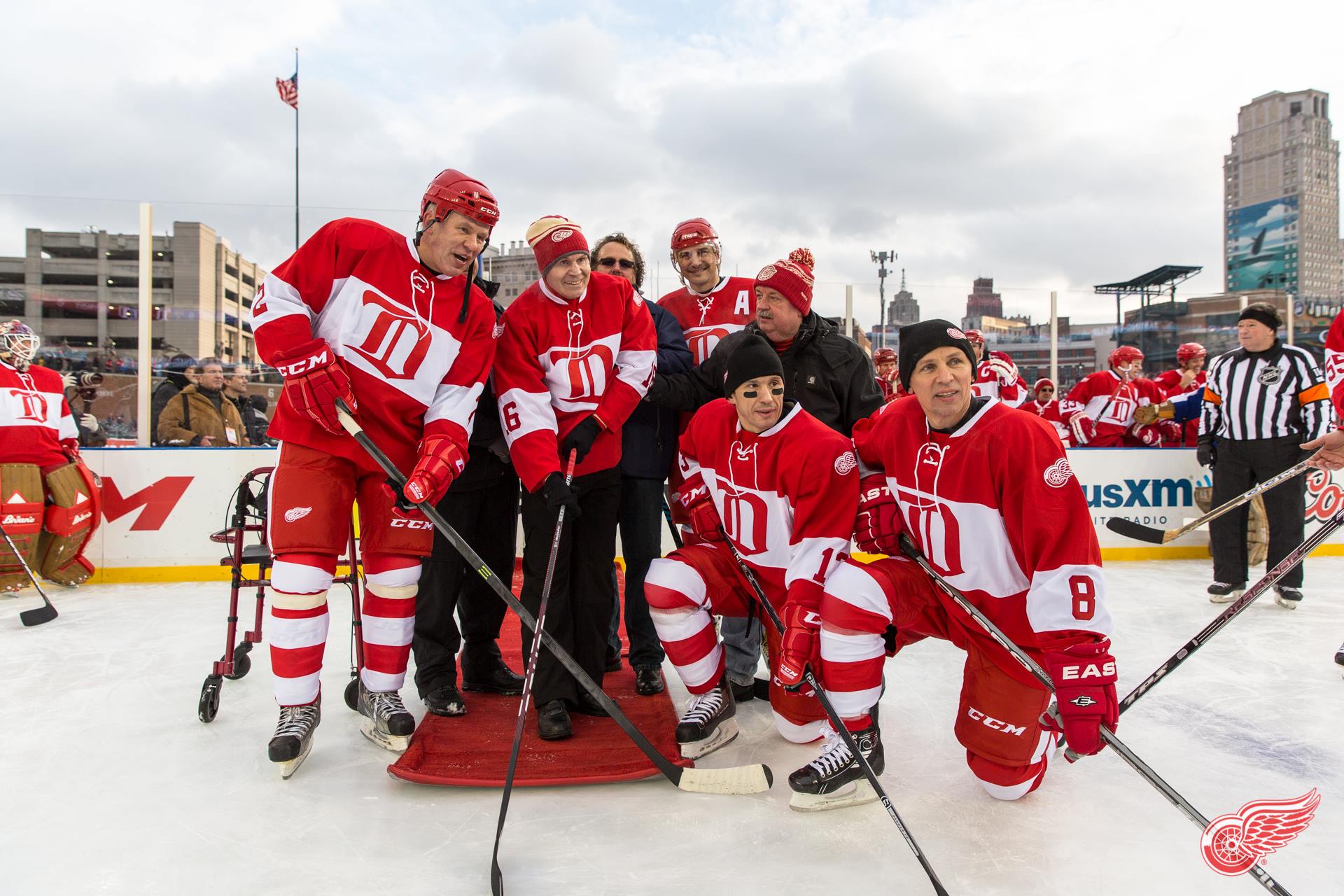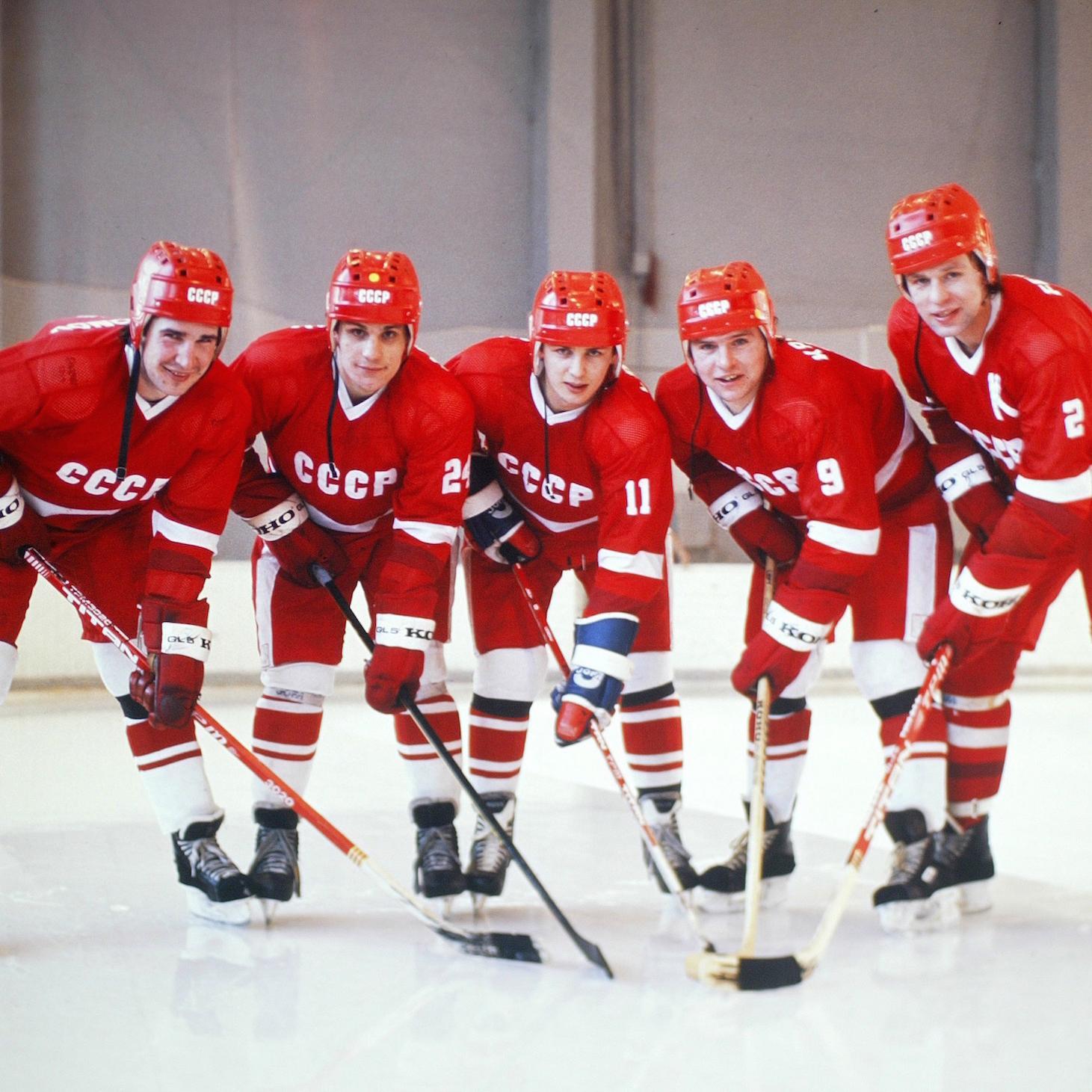So, a year ago, a Toronto sports reporter [who shall remain nameless][but whose name rhymes with “Brave Chesfuk”] broke the story that Brendan Shanahan was only into “puck possession” because it was… trendy.
Trendy.
Maybe best we let the author spell this out himself:
“The Leafs are making a valiant effort to get with the times under their nouveau-sophisticate president Brendan Shanahan.” However, Shanahan’s “analytics-fuelled thrust into the future” is doomed. Because even if the Leafs go “cuckoo for Corsi,” they’ve started too late and are a “mere lamb among a vast flock of sheep playing catch-up.”
Now, that’s the kind of article that can teach you a lot. A lot about indolence, for example. Because while our intrepid reporter is apparently an expert on sheep — and likely, on hoof rot — he missed out on one teensy, tiny little hockey-related fact:
That Brendan Shanahan actually learned puck possession in Detroit.
20 years ago.
In fact, Shanahan learned puck possession from the best – Scotty Bowman and the Russian 5. And he learned it from the ground up, as the approach was actually being redesigned for the NHL.
Then, after learning it, Shanahan played it well – really really well, as in Hall of Fame well – for 10 years. And won three Stanley Cups while surrounded by the world’s best at playing puck possession hockey.
Which means that Brendan Shanahan is no newcomer to puck possession.
No “Corsi kid.”
In fact, Shanahan has known puck possession longer – and in greater depth – than perhaps any NHL executive outside his old teammate Stevie Yzerman.
So… whoops!
What a Chesfuk.
And if you look close, it’s Brendan Shanahan’s commitment to puck possession hockey that is reshaping everything about the Leaf organization. By which, I mean:
Reshaping. Every. Thing.
For example, it reshaped Shanahan’s search for a new Leaf coach. Nowadays, every NHL coach claims to understand puck possession. Some of them even have Cup rings. But Shanahan picked his target… waited… and then got the very Coach who had taken up the puck possession torch of Scotty Bowman himself — Mike Babcock.
Or take the fact that both Shanny’s new Coach and his new GM – just like Scotty – love high-end, puck-handling Europeans and Russians. It’s a very different approach to that we saw under Brian Burke and Randy Carlyle, who cut the number of European Leafs to just two.
So when Shanahan’s new young Leafs with all their speed and skill get called up, there’s going to be some surprise.
At just how many of the new Leaf kids have European and Russian names across the back.
Puck possession even changed how Detroit drafted. And Shanahan saw what talent that approach produced, as a dozen or so picks ended up playing beside him.
It’s Shanahan’s experience from those years that is driving Toronto today, as it picks its New Generation Leafs.
And that’s why, style-wise, the new Leafs like Nylander and Timashov and Marner and Dzierkals and Bracco all fit better with the Russian 5 than with a Randy Carlyle team.
As with the young Russian who is “afraid of nothing” – Nikita Soshnikov.
In fact, as all that talent begins to pile up, it’s clear that a new Russian 5 is more than just a gleam in Shanny’s eye. It’s in the plan.
**
So Shanahan’s decision to go with puck possession is changing almost everything about the Leafs. I admit, I’ve been surprised as the changes have played out. Shocked even.
In particular, because Brendan Shanahan and Mike Babcock’s new puck possession Leafs remind me an awful lot of those Cup-winning Leaf teams of the 60’s.
Just look at them. Babcock’s new Leafs may start from a below-average talent base, but they’re disciplined. They play clean – no gooning. They skate. They pass. They work together as a team. And they aim to be tight on defence.
This new Leafs approach looks a heckuva more lot like a 1960’s Leafs team than any of Carlyle’s teams ever did. While Carlyle’s teams all seemed to have been modelled off the opposite, more of a Don Cherry “grind & goon” Boston-style approach.
Personally, there are times when I look at Shanahan’s Leaf rebuild and wonder if we haven’t stumbled onto a brighter timeline.
And frankly, it’s disorienting. Sometimes have to wait entire periods to hear the old standard, “And the Leafs clear the puck to the line… but not out.”
Watching the way Babcock’s Leafs play – after the Carlyle years – is as surprising as if Dave Keon and Jean Beliveau had lined up for the opening face-off… dropped the gloves and started hammering.
And Keon had foiled up.
I know, I know, Cherry’s told us for years that “real” Leaf teams were brawlers and consisted entirely of gritty fourth liners.
But just go look at the Leafs on Legends Row sometime [selections approved by Shanahan by the way]. Leafs like Teeder Kennedy and Syl Apps and Borje Salming and Mats Sundin, who were backed by Dave Keon and Red Kelly and Max Bentley and Frank Mahovlich and the like.
Every single one of these old-time Leaf legends was more about puck possession than cracking heads.
And each one of those old Leaf Cup-winning teams could skate and score and pass and play the damned game – not just fight about it.
So Brendan Shanahan is reconnecting today’s Leafs back to their own heritage, their own great players and teams. And if that means he has to cut out the previous failed attempt to turn the Leafs into the Flyers Lite or the Bruins North, then so be it. If he has to patch in some puck possession knowledge and skills – from the Russian 5 or Motor City or Thommie Bergman – then so be that as well.
Okay. The #1 thing driving the changes Shanahan is bringing to the Leafs? Puck possession hockey. And where did Shanny learn that? Detroit.
So. Road trip. Time trip.
Come on, let’s go.
***
Wherein: We watch a Bowman team that gets beat 10-1. [DAMMIT SCOTTY!!]
Detroit, Fall of 1996, was full immersion, puck possession hockey.
Fresh in from Hartford was Brendan Shanahan. In his 10th NHL year, his stats were huge, but he wanted a Cup. That’s why he went to Detroit.
Thing is, 1996-97 was the first full season that Scotty Bowman had all his Russian 5 puck possession wizards together right from get go in training camp. That meant Scotty finally had the chance to show his team how to play puck possession – on a new and higher plane.
Now, “puck possession” has become a common phrase in hockey in recent years, and some reporters apparently think it all started by counting Corsi. It didn’t. Just as some fans think it started in Detroit.
It didn‘t.
The best old hockey eyes will tell you that Scotty Bowman’s great Habs teams of the 70’s played a game with many elements of puck possession. Brett Hull talks about growing up watching it on the WHA’s Jets, with Hedberg-Hull-Nilsson-Sjoberg.
But it’s Scotty Bowman who rightfully gets the lion’s share of the credit as the man who brought puck possession back in from the margins, and developed it into an enormous NHL success in the 1990’s. But Bowman himself has repeatedly stated the credit should be more widely shared. In particular, with the Soviets.
Of course early on, the Soviets learned about puck possession from us. From shinny to fire-wagon hockey, Canadians have loved great stick-handling and skating – from Morenz to Beliveau, Gentleman Joe Primeau to the Bentley brothers, Keon and Kelly to Bobby Orr, and beyond.
But the truth is, once the Soviets took the Canadian influences home, they spent decades working on them, and developed them a lot further.
Bowman is quite forthright about this, about how early on the Soviet style influenced him. Back in 1956, in his first year of coaching, Bowman’s Ottawa Jr. team played the Soviets, like this:
“We got beat, in our rink, 10-1… Biggest shock I ever had. That was the first time I saw the Russians play. Of course, I became fascinated by them…”
And, “They played a different style – the puck possession game. Didn’t take a lot of shots… utilized all five players… They didn’t turn it over… and played a team-oriented game… a game that was so different… so much anticipation… A lot of our game came into theirs, and a lot of their game came into ours.”
Puck possession hockey, 40 years before Detroit.
After that game, Bowman became fascinated by Anatoly Tarasov and the Soviet’s style of puck movement and creativity. A fascination that shaped the Hab teams of the 70’s.
Tarasov even gave Bowman a pair of gloves that Scotty has worn for years at his practices.
Which means it wasn’t a surprise when it was Bowman and Sam Pollock in 1978 who first drafted a Soviet player. 20 year old Defenceman, Slava Fetisov.
Scotty eventually moved to Detroit, and had a talented team there, but it was one which kept just falling short. That’s why Bowman added Brendan Shanahan and some big wingers.
But Bowman has always said he made two critical trades at that time — one trade for Shanahan, the other for Igor Larionov.
In fact, Scotty traded for two veteran Russians – Slava Fetisov and Larionov, then 37 and 35 years old – who had once been part of the “Green Unit” in the USSR. The “Green Unit” having been merely been the single most dominant five man unit in hockey. For a decade. But Scotty wanted them for another reason.
Because they played insanely-successful puck possession hockey.
Scotty’s plan was to have the two Russian vets teach his three younger, but highly-skilled Russian kids [Fedorov, Kozlov and Konstantinov] how to play.
“Larionov and Fetisov had played on the original ‘Russian 5,’ so I didn’t have a lot to do with what they were doing. I just put them together… And having gone through a decade of that kind of hockey (in the USSR), they wanted to play a puck possession game.”
From the Red Army documentary:
“Their passing skills, skating skills, conditioning was all a surprise to people in North America… When I did get the 5 Russians, they played a totally different style. We were surprised ourselves.
We didn’t design any of that. It just so happened, it evolved… When they got together, they designed their own plays… Some of the goals they scored were highlight reel goals… the Harlem Globetrotters on ice…”
Bowman always made clear the difference in the Russian 5:
“These guys brought a completely new style of hockey to the NHL.”
Detroit GM Kenny Holland said,
“When Scotty put together the Russian 5, that was really the start of the Red Wings we see today.”
***
Wherein: It was twenty years ago today when the Russian 5 taught the Wings to play [DAMMIT DATSYUK!!]
The Russian 5 first hit the ice together 20 years ago, on October 27, 1995.
https://www.youtube.com/watch?v=4TWGTKxktBo
They tore the league apart. Detroit won 62 games that year. The most by any team, ever.
Even we Leaf fans remember – and give thanks for – that delicious 11-1 beating inflicted upon Montreal, during which Patrick Roy demanded a trade. [And after which, the Habs haven’t won dirt.][trolololololololol.]
And in terms of the Russian 5’s individual stats, well…
Vladimir Konstantinov had a +60 plus/minus in 1995-96, a record unmatched in 25 years since. Sergei Fedorov got 107 points, and won the Selke. Slava Fetisov was 37 years old, but scored 42 points – the most by any Defenceman that age. Igor Larionov was 35 years old, and went point-per-game. And so on.
But the Wings lost the Cup that year, to injuries and a hot goalie (o hai Patrick!). In Scotty’s mind – even though the 5 played well – the team as a whole didn’t play well enough on defense.
That is why – Fall of 1996 – Scotty was busy adapting his system. At its core was the puck possession style, led by the Russians. Igor Larionov described it as built around “puck control, improvisation and constant movement,” and above all, “thinking fast.”
Scotty’s problem was simple. Unlike the Red Army, he couldn’t drill his players 24/7 for 11 months a year.
So Bowman had to adapt puck possession into a new form, one fit for the NHL.
For starters, Bowman decided to play the Russian 5 together mostly just during big games and the playoffs. His official rationale being that this made it harder for other teams to plan to defend against.
But this move also gave him a huge side-benefit. Bowman now had five of the world’s best possession players, who he could spread across his lines and pairings as needed. It would help nudge everyone, game by game, quietly and invisibly, up the learning curve.
And that was useful, because to the Detroit players of the time, the gap between how they had been playing, and the Russian possession style, was almost overwhelming. Kris Draper said:
“When they first started playing together, everybody on the bench would just watch them and couldn’t believe what we were seeing.”
Here’s Brendan Shanahan on the same issue, from just last year:
Bowman also began to use the 5 Russians to fill those defensive holes that were bothering him. He had been drilling the Wings in his left-wing lock defensive system, and adding the big wingers and fast-skating Russians helped that work.
But now he could use Igor Larionov as his centerman to defend leads late in the game. And when needed, put Sergei Fedorov – a Hart-winning, 100 point forward – back on defence, including one season for six weeks straight.
And so, that Fall, things came together in Detroit.
The result?
In the 11 seasons after the Russian 5 rolled out and Scotty’s puck possession designs got full play, the Wings won four Stanley Cups.
And only missed a 5th by a goal in the 7th game. They won both the 1997 and 1998 Finals sweeping them, four games to zeo — something nobody has done since. As for those defensive problems? Detroit ran a 1.89 Goals Against Average in their four successful Cup runs.
And all in all, Shanahan felt pretty good about the new approach.
***
Although, as time went along, Detroit realized that more change was needed. If they wanted to maximize the benefits of puck possession, they needed to do more than maximize their use of the 5 Russians.
They needed change right across the organization.
For starters, the aim of puck possession is to actually have the puck, and to do creative, offensive things with it, which meant Detroit needed a constant inflow of creative, top-end puck handlers.
But finding that level of creativity isn’t easy.
Most NHL’ers could learn the basics of puck possession – working in four and five player units, making short rapid passes, the positional and defensive aspects. But for many players, actual puck-handling and creative play had been drilled out of them by their coaches.
The early Wings teams started with the Russian 5, plus Stevie Y and Nick Lidstrom – one helluva top-end group of puck-handlers. They then bought or traded for top-end North Americans who could handle the puck – players like Shanahan, Hull, Chelios, and Larry Murphy.
But it became difficult to find NHL’ers with the skills and the creativity to handle the puck all night and to actively create goals.
If the Wings wanted that flow to continue, they knew their scouting and drafting had to change. Puck possession demanded kids with better skating, passing and puck-handling skills. It meant scouting the leagues where those skills were most intensively taught, and which were least-heavily scouted.
That meant more scouting and drafting from Europe and Russia.
The Wings had been dipping into Europe for years, usually taking one, two or three kids per draft. But even after their amazing 1989 haul [of Lidstrom, Fedorov and Konstantinov], they would go through drafts without taking a single European kid.
But after the full Russian 5 landed, Detroit began taking three, six, even eight Europeans per draft, using their high as well as their low picks.
The Wings also realized that for their top-end puck-handlers, they might need to reduce their size criteria, and take some smaller kids.
Put the pieces of that strategy together, combine it with a serious investment in European scouting, and you become a team more likely to find, and pick, a Pavel Datsyuk.
But make no mistake, it wasn’t just Datsyuk.
And it wasn’t just luck.
Detroit has succeeded in their drafting, year on year on year, by actively scouring Europe for strong puck-handlers and skaters, and by not being afraid of smaller players. That’s how they found: Hudler at #58, Nyqvist at #122, Pulkkinen at #112, and Tatar at #60.
All kids who could skate and handle the puck. All between 5’9 and 5’11, 170 to 185 pounds. And all from Europe.
A second change was that Detroit’s coaches, players [and minor league coaches] had to learn that creative puck-handlers make mistakes.
Patience became vital as well.
Larionov said:
“I remember Datsyuk made a couple of turnovers when he first came in… And Brett Hull, Brendan Shanahan, Steve Yzerman and myself told him, ‘Pavel, just keep doing what you’re doing.’ Thankfully, Scotty Bowman had the wisdom to see his potential… But with a different coach… Datsyuk might have been out of the league.”
As Bowman saw it:
“They were brought up with puck possession. They would take chances with the puck and there would be times when they might get burned a little bit. That was offset by the great number of chances they created. A little bit risky, because the odd pass could be picked off, but the odds were much in their favour.”
Piece by piece by piece, puck possession changed Detroit.
***
So to Brendan Shanahan, puck possession is not a fad. It’s not something that started with counting Corsi. It’s the engine that made Detroit work for 20 years. It’s the system that gave him his greatest career success.
To Brendan Shanahan, it’s pretty much how you play hockey.
And now, he’s using it to transform Toronto. Because when it comes to puck possession…
Brendan Shanahan isn’t Chesfuking around.
Continue reading this series from Quinn MacKeen:

































